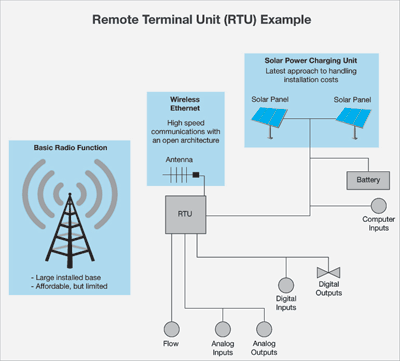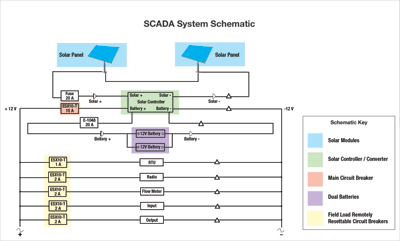Enhanced circuit protection for SCADA/RTU systems
Circuit protection with remote reset functionality is important for battery-powered solutions in the SCADA application environment
BY STEPHEN STARR
Business Development
Automation Specialist, E-T-A
www.e-t-a.com
Process automation projects are most often driven by bottom line results, return on investment and an appropriate value position or justification. More and more, systems are expected to:
• Provide access to quantitative measurement points of important processes
• Detect and correct problems immediately
• Measure trends
• Pinpoint and eliminate bottlenecks
• Control larger and more complex processes within a large geographic area
• Maintain constant communications and an uninterrupted power source
All of this can be accomplished with the use of a SCADA system within the automation process. However, none of these functions are available if the system is not designed with a reliable power source for the remote panel portion of the SCADA system.
The focus of this article is to address the need to use the latest circuit protection technology available to increase the efficiency of a battery powered remote panel deployed with a SCADA system. Before we can go into the details of the newest circuit breaker technology for SCADA systems, we need to review what a SCADA system is and its function within the automation process.
Introduction to SCADA
Supervisory control and data acquisition, better known as SCADA, is not considered a technology, but rather a type of automation application. SCADA is used in systems where real time data is mandated and is gathered from multiple areas or locations of the automation process located anywhere from a few hundred feet to miles away from a central control panel.
SCADA systems provide sensing and monitoring capabilities, as well as the computational power to track everything relevant to the process and manufacturing operations. This is accomplished with the use four basic component groups:
1. Sensors and instruments: Devices measuring the variables of the process connected to a dedicated controller.
2. Remote telemetry unit (RTU): Small computerized units deployed in the field at specific sites and locations. RTUs serve as local collection points for gathering data from sensors and delivering data & commands to the master unit (See Fig. 1 )
3. SCADA master units: Typically an industrial grade PC which displays detailed graphics of all the field devices and has the ability to process multiple communication interfaces and protocols. The graphics represent the actual field devices in the form of a gauges or some type of device status, such as pumps, flow meters, tank levels, temperature gauges, and switch position.
4. Communication networks connect the SCADA master units to the RTUs in the field: There are many communication interfaces and protocols available from very simple to very sophisticated with extremely high speed and large volumes of data. Early SCADA systems used basic serial communication, running at a very slow speed of 1,200 baud (number of times the signal changes in a second) over a radio-based transmitter/receiver. This approach worked fairly well for the amount of data required over radios with relatively short distances. Today, typical systems are operating at 100 Mbits/s over similar radio technology or wireless Ethernet technology, allowing communication now to reach distances of 10 to 20 miles consistently.

Fig. 1: RTUs serve as local collection points for gathering data from sensors and delivering data & commands to the master unit
SCADA in automation processes today
SCADA is currently used across multiple industries to gather real-time data and communicate back to system engineers. Table 1 outlines some examples of how SCADA systems are currently being used today. This table barely scratches the surface of the potential uses of SCADA systems. SCADA is incorporated in nearly every industry and public infrastructure project anywhere automation is used to increases efficiency.
| SCADA Applications in Various Industries | |
| Industry | SCADA Application |
| Oil and gas | Monitor the flow of raw product from the oil wellheads through the network of pipelines to the refinery plants and end user locations. |
| Electric utilities | Detect current flow and line voltage, monitor the operation of circuit breakers, and switch sections of the power grid on or off. |
| State and municipal water utilities | Monitor and regulate water flow, reservoir levels, pipe pressure, and other factors. |
| Facility managers | Control HVAC, refrigeration units, lighting, and entry systems. |
| Manufacturing | Manage parts inventories for just-in-time manufacturing, regulate industrial automation and robots, and to monitor process and quality control. |
| Transit authorities | Regulate electricity to subways, trams, and trolley buses; automate traffic signals for rail systems; track and locate trains and buses; and control railroad crossing gates. SCADA regulates traffic lights, controls traffic flow, and detects out-of-order signals. |
Shortcoming of SCADA
SCADA systems are using more and more battery based power sources connected to solar power re-charging units for remote field enclosures in order to avoid running expensive AC power lines. Industrial batteries have evolved over the years to provide longer term power than in the past, in most cases up to 36 hours or more.
Along with battery improvements, the RTU, radio communication, and instrument manufactures have reduced the amount of current required to operate these devices to monitor and collect data. These factors have driven SCADA architectures to incorporate battery systems as the primary power source. While there is great deal of value available with this design approach, one area of concern needs to be addressed: short-circuit and overload protection.
Traditionally, automation applications have used fuses or low cost circuit breakers to provide the overload and short circuit protection for components installed in enclosures and in the field. Fuses will quickly detect a fault in any of the components installed and provide disconnection from the power source. Standard circuit breaker technology provides a few options to select from, including: thermal, thermal-magnetic, and magnetic. Similar to a fuse, each of these devices fit a specific type of protection for short circuit and/or over current protection and provide disconnection from the power source.
However, both of these technology approaches have a significant deficiency which SCADA systems have a difficult time dealing with. Once the device trips as a result of a fault, it immediately goes offline and the protection device must be manually reset or replaced to bring the device back online. This requires a field engineer to travel to the panel location and reset the breaker or replace the fuse. The downtime of a SCADA system due to a fault is highly inefficient and very costly.
Additionally, when data is not available to the SCADA master unit it is blind to what is happening in the field and in some cases this information is tied to revenue generation for the end customer. Most of these systems have redundant devices in place to have multiple measuring points feeding the SCADA system, which helps deal with a single device going offline. Not all industries can afford redundancy of devices, and there could be a fair distance between devices, which might cause alarms or errors in how the overall SCADA system reacts to a single point of failure.
Remote reset circuit protection
Let’s now take a look at a new circuit breaker technology based on solid state electronic MOSFET technology with integrated remote reset input. For the first time, circuit protection can be integrated into an RTU as seamlessly as the field devices, providing the convenience of resetting or cycling the power to any of the components connected in the remote panel.
In the event of a fault, the electronic circuit breaker immediately detects and disconnects (in as little as 100 ms at 1.8 times rated current) the faulty load in the circuit and enables a system engineer to reset the circuit breaker remotely with a simple relay, pushbutton, or RTU output via a command from the SCADA master unit over a wireless radio communication network (see Fig. 2 ). Compared to traditional circuit protection solutions, whether it is a fuse or a traditional circuit breaker, using a remotely resettable electronic circuit breaker will prolong the energy life of the batteries, and deliver more productivity of the entire SCADA system.

Fig. 2: In the event of a fault, the electronic circuit breaker immediately detects and disconnects the faulty load in the circuit and enables a system engineer to reset the circuit breaker remotely.
To deploy a remote panel in any architecture, whether the distance is 500 feet or miles away, the panel needs to be self sufficient or have the ability to be controlled from a centrally located controller. Serviceability or the lack there of is an extremely important attribute of the remote panel in a SCADA system.
If a remote panel needs to be visited or maintained on a regular interval to deal with any of its components or its overall functionality, then its inefficiency will increase the cost of the entire SCADA system over time. As battery powered solutions become more acceptable in the SCADA application environment, so will the need for the appropriate circuit protection with remote reset functionality. ■
Advertisement
Learn more about E-T-A Circuit Breakers





